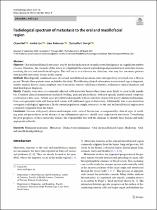| dc.description.abstract | Objective Oral and maxillofacial metastasis may be the frst indication of an undiscovered malignancy in a signifcant number
of cases. Therefore, the rationale of this article is to highlight the clinical and radiological presentation of metastatic lesions
involving the oral and maxillofacial region. This will serve as a reference for clinicians, who may frst encounter patients
with possible metastatic lesions in this region.
Methods Histologically confrmed cases of oral and maxillofacial metastasis were retrospectively reviewed over a 30-year
period. Twenty-three patients were included in the study. The following clinical information was reviewed: age at diagnosis,
gender, medical history, main complaint, site of metastatic tumour, radiological features, preliminary clinical diagnosis and
fnal histological diagnosis.
Results Females were twice as commonly afected, with metastatic lesions three times more likely to occur in the mandi ble. Common clinical presentations included swelling, pain and paraesthesia, with non-specifc dental-related symptoms
occurring in a few cases. Fifteen cases presented radiologically with an osteolytic lesion with poorly demarcated margins.
Four cases presented with well demarcated lesions with additional signs of destruction. Additionally, four cases showed an
osteogenic radiological appearance. In the current population sample, metastasis to the oral and maxillofacial region most
commonly originated from the breast.
Conclusion Lesions with poorly demarcated margins with cortical destruction, accompanied by clinical signs of swell ing, pain and paraesthesia in the absence of any infammatory process, should raise suspicion for metastasis. Considering
the poor prognosis of these metastatic lesions, the responsibility lies with the clinician to identify these lesions and make
appropriate referrals | en_US |

